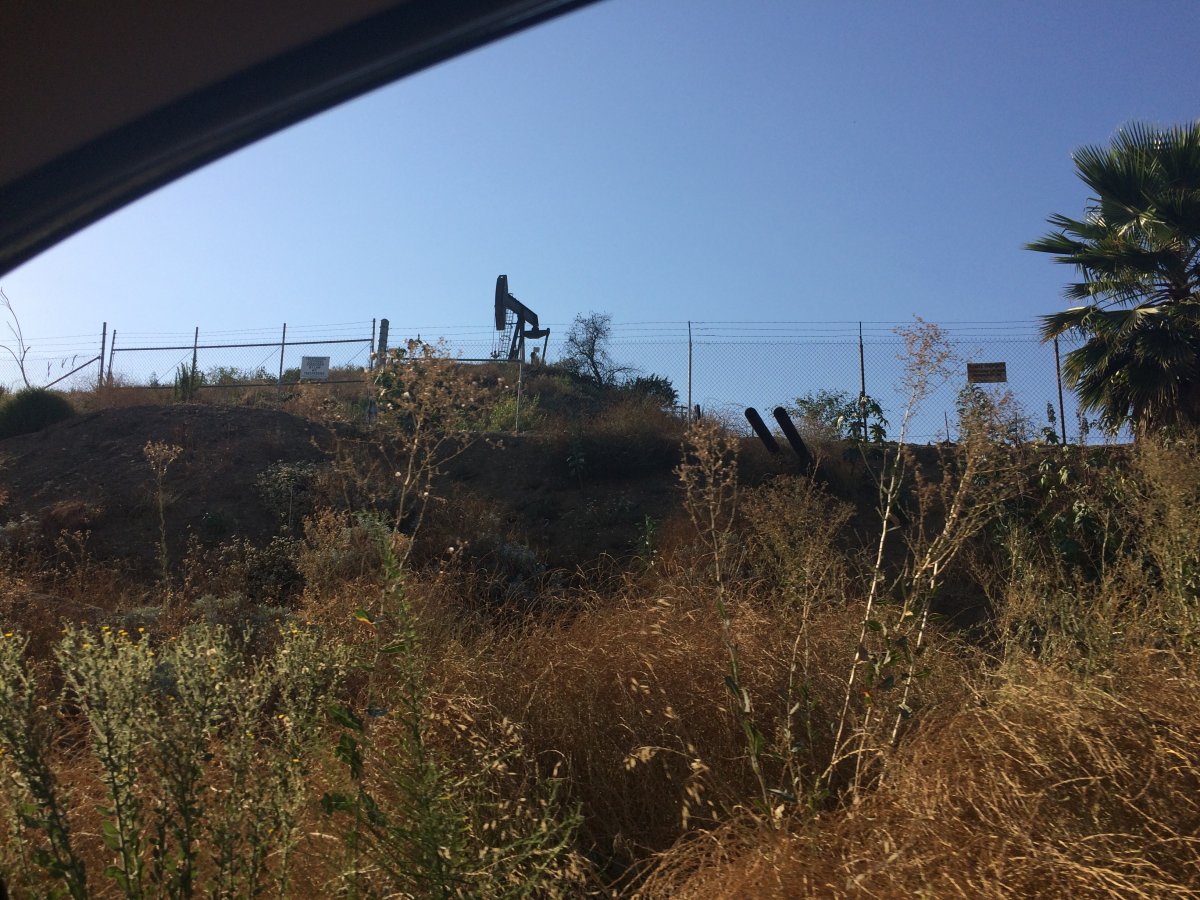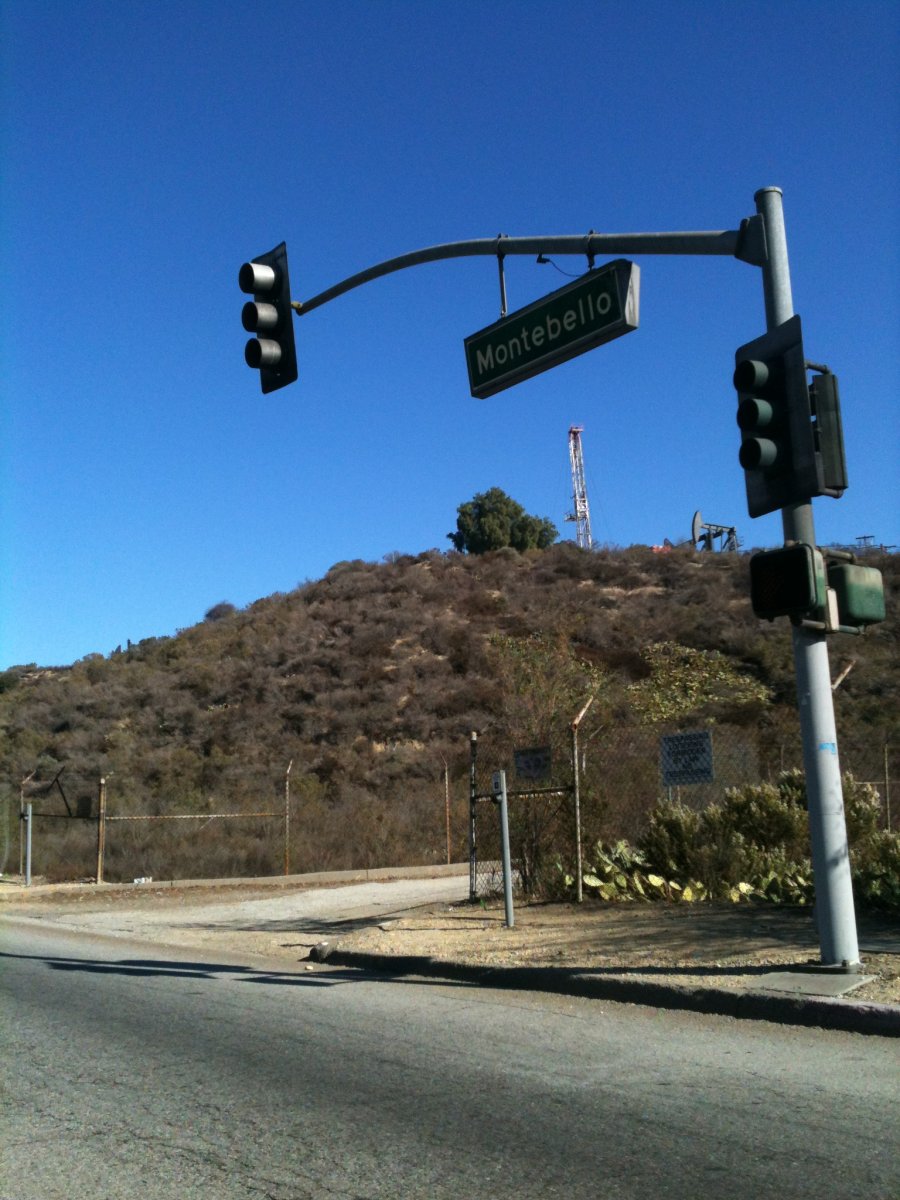July 31, 2019

Pumpjack By Megan Rae Watson
When most people think of oil and gas wells, they probably picture a fenced off oilfield with hard-hatted employees who try to keep the curious away from danger, but plans for a new housing development in the Montebello Hills will actually put people at risk of serious harm.
The roughly sixty-three thousand residents of Montebello, just east of Los Angeles, are used to sharing their hills and sloping plain with oil and gas wells. After all, oil was first discovered in the Montebello Hills in 1917 and by 1920, Montebello’s wells were producing one eighth of California’s crude oil. Today though many residents don’t remember what it’s like to have an active well as a next-door neighbor.
The Montebello Oilfield produces 1,800 barrels of oil and 67,000 standard cubic feet of natural gas a day. Its current owner, Sentinel Peak Resources, plans to increase production in the next few years. The oil company also intends to move forward with a previously approved housing project and has a signed agreement with Toll Brothers, a luxury home developer.
The project known as the Montebello Hills Specific Plan is a 1,200-unit housing development that would literally be built in the middle of a working oilfield. Research has shown that living near oil and gas wells is not safe and can lead to serious health issues for children, pregnant women, the elderly and persons with compromised immune systems.
Entrance to the housing development, by Yvonne (Martinez) Watson
How close is too close?
The California Council on Science and Technology has stated, “Oil and gas development poses more elevated health risks when conducted in areas of high population density, such as the Los Angeles Basin, because it results in larger population exposures to toxic air contaminants.1
The County of Los Angeles Public Health Department recommends “…County and local jurisdictions within the County should expand the minimum setback distance beyond 300 feet, as currently specified in local zoning code, and apply these requirements to both the siting of new wells and to the development of sensitive land uses near existing operations.”2
In 2009, the South Coast Air Quality Management District (SCAQMD) sent a comment letter3 to the City of Montebello:
“The SCAQMD is concerned that residents and other sensitive receptors in the proposed residential development would be exposed to borderline significant levels of cancer risk and significant operational NOx emissions from the active oil field operations that will continue to operate 24 hours per day, seven days per week within the proposed development…
Therefore, the SCAQMD is concerned about the incompatibility of the proposed project with the adjacent ongoing oil field operations where residents would be exposed to elevated air toxic emissions and significant criteria pollutant emissions.”
In 2013 the SCAQMD adopted Rule 1148.2 which now requires well operators to provide information about the “nearest sensitive receptor within 1,500 feet of the subject well(s).”4 A sensitive receptor is basically any type of home, school, or medical facility.
STAND LA5, an environmental justice coalition, is campaigning for a 2,500’ health and safety buffer around all urban well sites within the City of Los Angeles.
The Environmental Impact Report for the Montebello Hills housing project revealed homes could be built as close as 150’ from a well cellar containing 10 to 15 wells.6 The oilfield also has a gas treatment plant which could be as close a 730’ from the nearest residence.
The risks inherent in these man-made hazards are compounded by natural hazards: fire and earthquakes.
This oilfield has been the site of two significant fires in the past seven years. Its eastern section ends in a wildland/urban interface with the nearby Whittier Narrows which has experienced numerous small spot fires. Neighboring cities to the east maintain severe Fire Resource and Assessment (FRAP) ratings.
The Whittier Fault and the Puente Hills Fault are respectively seven and eight miles away. The 1987 Whittier Narrows Earthquake killed several people, injured hundreds and caused an estimated $2-3 million in property damage. It also raised the entire Montebello Hills by 5 centimeters.7
The Whittier Fault and the Puente Hills Fault are respectively seven and eight miles away. The 1987 Whittier Narrows Earthquake killed several people, injured hundreds and caused an estimated $2-3 million in property damage. It also raised the entire Montebello Hills by 5 centimeters.7
Sadly, the City of Montebello approved the Montebello housing project on June 10, 2015. A local citizens’ group immediately launched a California Environmental Quality Act lawsuit but were unsuccessful.
Yet all is not lost.
This housing project has been and is still being actively opposed by the Sierra Club Angeles Chapter for its numerous environmental and public health/safety impacts.
The Montebello Hills oilfield host pockets of California Coastal Sage Scrub habitat and a core population of California gnatcatchers. These small songbirds are listed as threatened under the Endangered Species Act. In 2009, the US Fish and Wildlife Service issued a Biological Opinion for this project that requires the developer to create a 260-acre gnatcatcher reserve. This restored habitat requirement is part of a Mitigation, Monitoring and Reporting Plan. The housing project cannot move forward without final approvals from the USFWS.
Two months after the housing project was approved by the City of Montebello, the Hills experienced the first of several wildfires that left serious impacts on the native plants and animals. It was also around this time that members of the Angeles Chapter first learned that Central Basin Municipal Water District was planning a separate, recycled water pipeline and pump station project to serve the massive grading, construction and irrigation needs of the housing development. This was very alarming because the location of the pump station was on land set aside for the gnatcatcher reserve, a location that was not a part of the approved environmental impact report.
In a July 9, 2019 telephone interview, Christine L. Medak, the lead biologist for the USFWS said she hadn’t known about this new, recycled water project until she was contacted by the Angeles Chapter.
Ms. Medak said she was still in the process of reviewing an official packet of information she had received yet the CBMWD Board of Directors was scheduled to hold a vote to approve a Mitigated Negative Declaration the very next morning.8
When asked for her opinion about the wisdom of constructing a recycled water pipeline and pump station before the Montebello Hills housing development receives its final approvals and permits from USFWS her response was, “They (CBMWD) do it at their own risk.”
Based on these facts and additional information provided by the USFWS, members of the Angeles Chapter were able to persuade the Board of the CBMWD to reject the certification of their own MND.
For the Record: The Sierra Club supports the use of recycled water rather than potable water for construction and landscaping. In this particular case though, we were concerned about the use of approximately $700,000 in public money to move forward on a recycled water project which would serve a single, private development project that is clearly not shovel ready9 and without a guarantee the District would see a quick return on its investment. The District could have been left with a pipeline to nowhere for several years or longer.
We encourage the District to pursue other recycled water customer opportunities within its jurisdiction. There are still many existing schools, parks, parkways, and other customers who would welcome the chance to purchase recycled water from the Central Basin Municipal Water District.
Will the end of this recycled water project stop the housing project? Probably not, at least not by itself, but it may give the real estate buying public more time to catch on that living next to oil and gas wells is not a good idea.
In a fortuitous twist of roles, this time a small bird may save a human being from an oily demise.
Get Involved!
For more information about the topics discussed in this article and/or to volunteer with the Sierra Club please contact:
Yvonne (Martinez) Watson, Chair, Environmental Justice Committee
Linda Strong, Co-Chair, Save the Montebello Hills Task Force
Michael Popoff, Co-Chair, Save the Montebello Hills Task Force
Charming Evelyn, Chair, Water Committee
David Haake, Chair, Clean Break Committee
-----------
1An Independent Scientific Assessment of Well Stimulation in California, Volume 1, Executive Summary, Pag 13 https://ccst.us/reports/an-independent-scientific-assessment-of-well-stimulation-in-california-volume-1/
2Public Health and Safety Risks of Oil and Gas Facilities in Los Angeles County, Los Angeles County Department of Public Health February 2018 http://publichealth.lacounty.gov/eh/docs/PH_OilGasFacilitiesPHSafetyRisks.pdf
3SCAQMD DEIR Comment Letter, 2009 http://www.aqmd.gov/docs/default-source/ceqa/comment-letters/2009/june/proposed-montebello-hills-specific-plan.pdf
4Oil and Gas Well Electronic Notification and Reporting http://www.aqmd.gov/home/rules-compliance/compliance/1148-2
5STAND LA, https://www.stand.la/
6Montebello Hills Specific Plan, https://www.cityofmontebello.com/montebello-hills-specific-plan.html
7THE SOUTHERN CALIFORNIA NETWORK BULLETIN JULY DECEMBER, 1987 Open-File report 89-323, Page 11 https://pubs.usgs.gov/of/1989/0323/report.pdf
8CBMWD Special Meeting, July 10, 2019, https://www.centralbasin.org/UserFiles/Servers/Server_8977649/File/Board%20of%20Directors/Board%20Agendas%20and%20Minutes/2019/Special%20CB%20Board%20Agenda%2007-10-2019.pdf
9The Montebello Hills Oilfield has been bought and sold several times since a housing development was first proposed by Chevron in the early 1990’s. Chevron sold the oilfield to Stocker Resources, a predecessor to Plains
Exploration & Production Company (PXP). PXP was the proponent of the Montebello Hills Specific Plan. In 2012, PXP was purchased by Freeport-McMoRan Copper & Gold Inc. As of 2017, the current owner of the oilfield is Sentinel Peak Resources.
